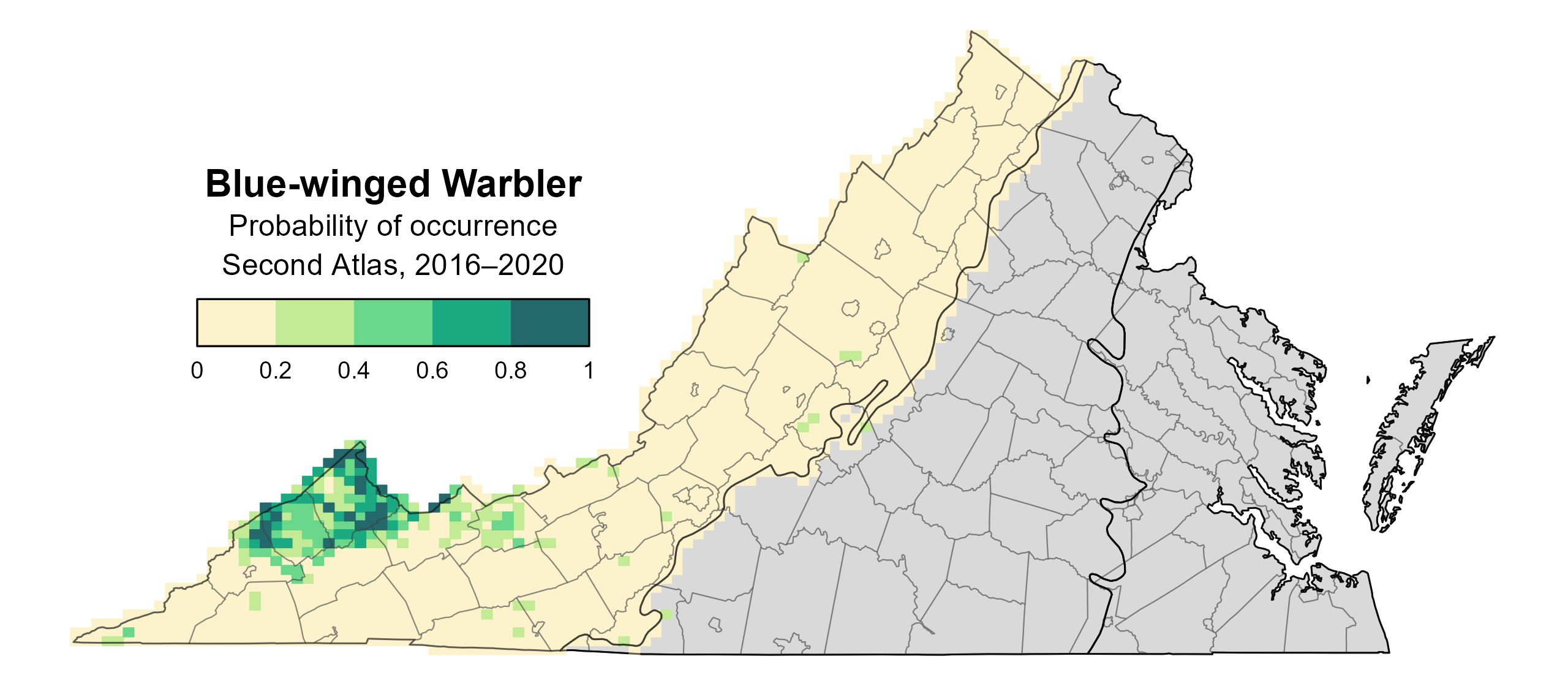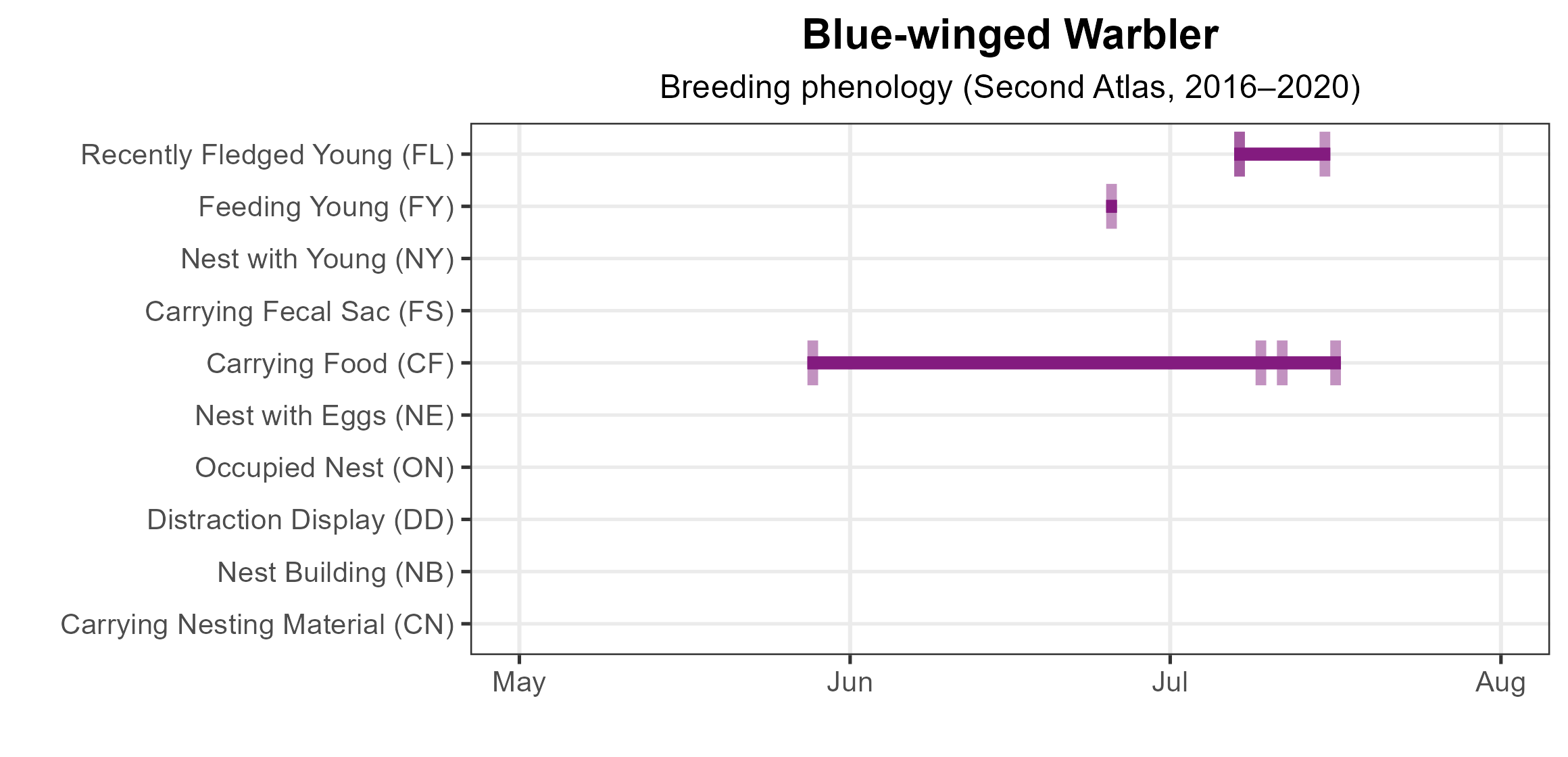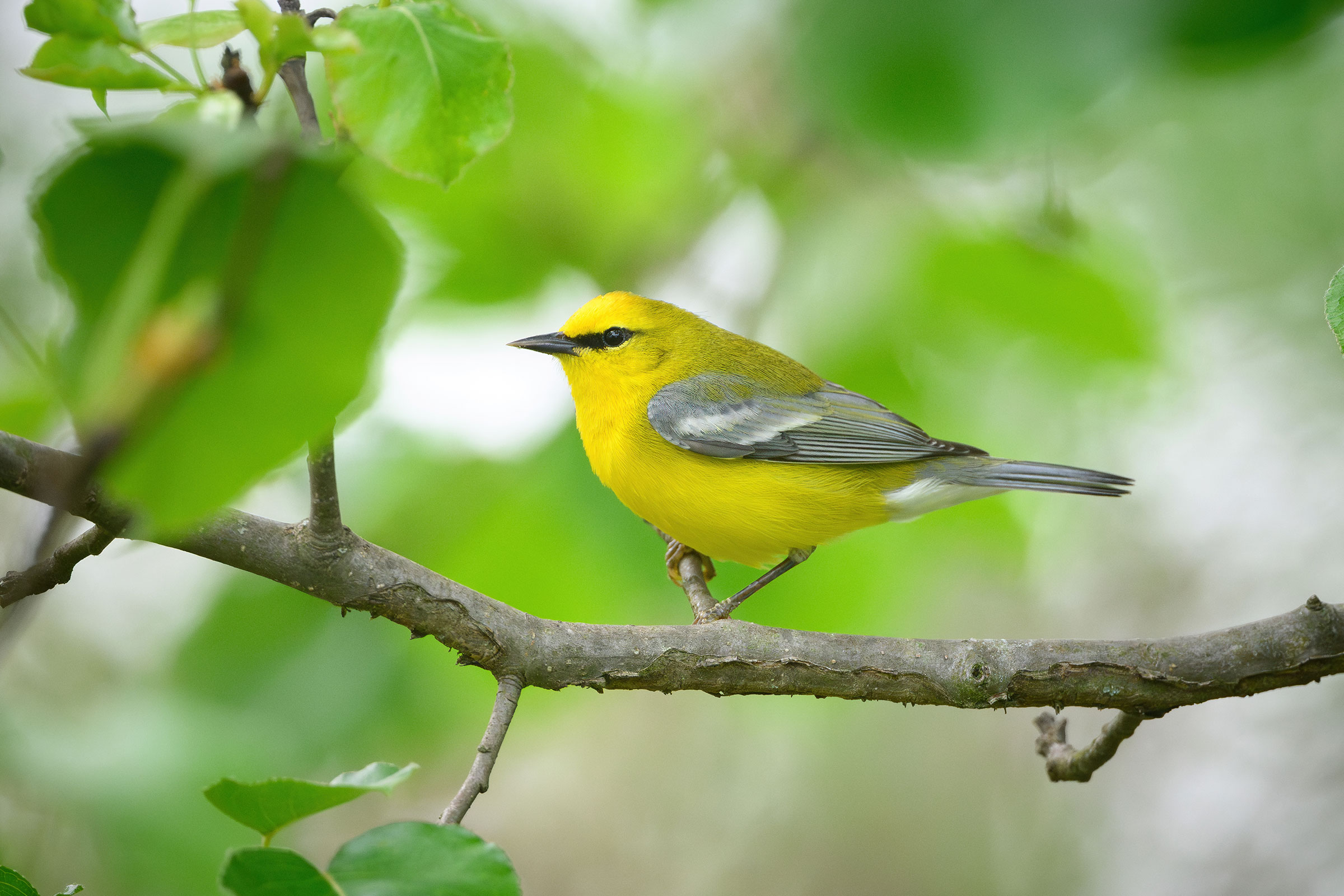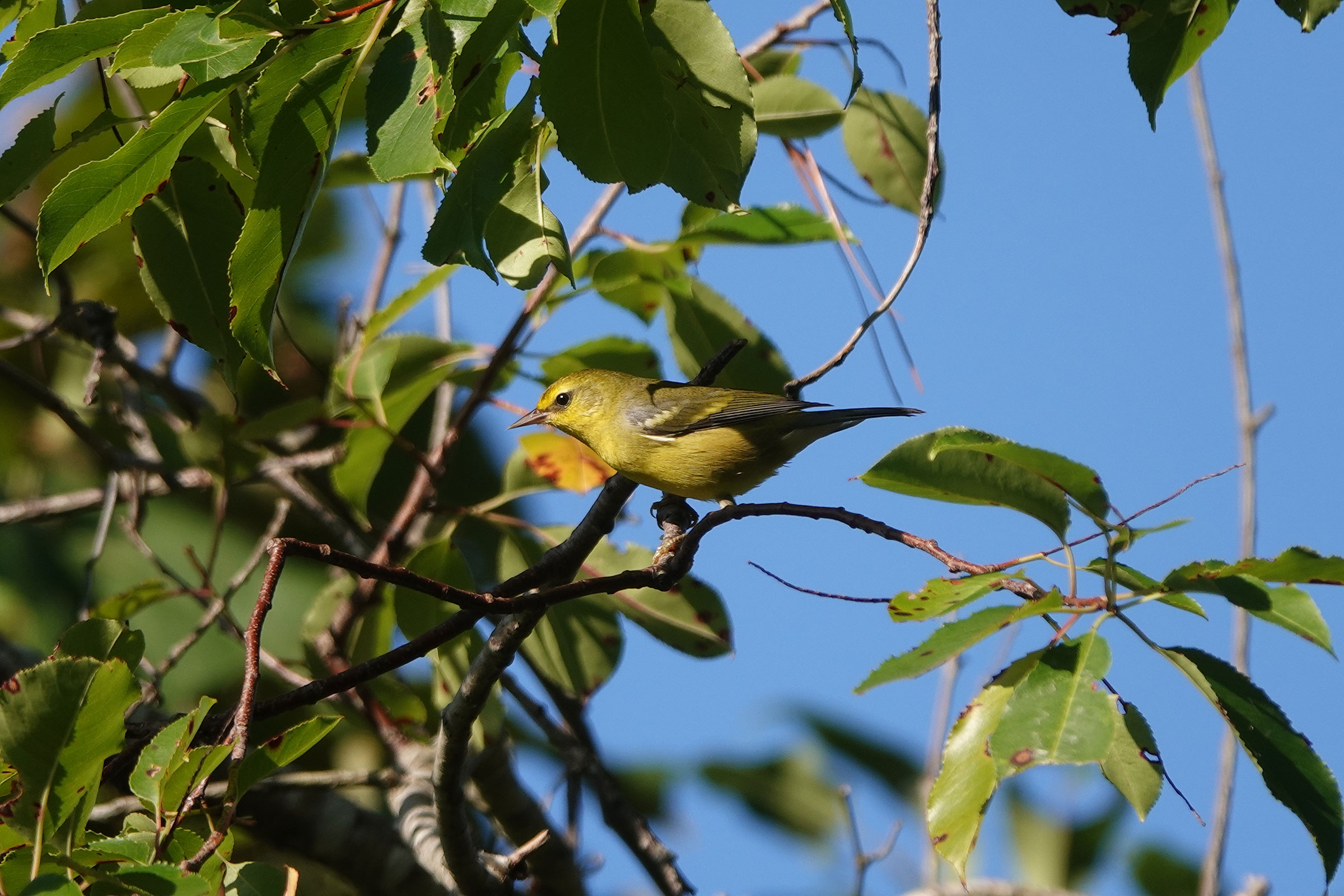Introduction
The Blue-winged Warbler’s breeding distribution covers the northern-central and northeastern United States and stretches as far north as southern Minnesota in the west and to southern Maine in the east. In the Mid-Atlantic region, Virginia rests at the very eastern edge of the species’ range (Roth et al. 2019). The Blue-winged Warbler and the closely related Golden-winged Warbler (Vermivora chrysoptera) both rely on young forest and old field habitats in Virginia’s Mountains and Valleys region, although they are often found at different elevations (Lin and Bulluck 2023). The Blue-winged Warbler is also found in additional habitat types, including utility rights-of-way, reclaimed mines, shrublands, and wetlands (Wilson et al. 2007).
Breeding Distribution
Blue-winged Warblers breed in the western Mountains and Valleys region, where most of the breeding population is found in the far southwestern counties, including Buchanan and Dickenson (Figure 1). These counties lie within the thin sliver of the Cumberland Plateau, which skims along southwestern Virginia. Blue-winged Warbler occurrence is strongly positively associated with grassland and shrubland habitat, as well as the prevalence of edge habitat and understory shrub cover. They are most likely to occur in blocks with regenerating young forest and/or open areas adjacent to forest edge habitat.
Due to data and model limitations, Blue-winged Warbler distribution during the First Atlas and its change between the two Atlas periods could not be modeled (see Interpreting Species Accounts). For more information on its distribution during the First Atlas, please see the Breeding Evidence section.

Figure 1: Blue-winged Warbler breeding distribution based on probability of occurrence (Second Atlas, 2016–2020). This map indicates the probability that this species will occur in an Atlas block (an approximately 10 mi2 [26 km2] survey unit) based on environmental (including habitat) factors and after adjusting for the probability of detection (variation in survey effort among blocks). Blocks in gray lie outside the core range of the species and were not modeled.
Breeding Evidence
Blue-winged Warblers were confirmed breeders in only six blocks and four counties (Botetourt, Buchanan, Loudoun, and Tazewell) and found to be probable breeders in seven additional counties (Augusta, Dickenson, Frederick, Highland, Russell, Smyth, and Wise) (Figure 2). During both Atlas periods, confirmation records were recorded only in the Mountains and Valley region, with several probable and possible records in the Piedmont region (Figures 2 and 3).
The earliest confirmed breeding behavior was observed on May 28, when adults carrying food were documented. Other breeding confirmations were observations of recently fledged young (July 7 – July 15) and adults feeding young (June 25) (Figure 4).
For more general information on the breeding habits of this species, please refer to All About Birds.

Figure 2: Blue-winged Warbler breeding observations from the Second Atlas (2016–2020). The colored boxes illustrate Atlas blocks (approximately 10 mi2 [26 km2] survey units) where the species was detected. The colors show the highest breeding category recorded in a block. The numbers within the colors in the legend correspond to the number of blocks with that breeding evidence category.

Figure 3: Blue-winged Warbler breeding observations from the First Atlas (1985–1989). The colored boxes illustrate Atlas blocks (approximately 10 mi2 [26 km2] survey units) where the species was detected. The colors show the highest breeding category recorded in a block. The numbers within the colors in the legend correspond to the number of blocks with that breeding evidence category.

Figure 4: Blue-winged Warbler phenology: confirmed breeding codes. This graph shows a timeline of confirmed breeding behaviors. Tick marks represent individual observations of the behavior
Population Status
Due to limited detections during the point count surveys, an abundance model for the Blue-winged Warbler could not be developed. Similarly, data from the North American Breeding Bird Survey (BBS) were insufficient for determining reliable population trend estimates for the Blue-winged Warbler in Virginia. However, BBS data at the Appalachian regional scale show that this species experienced a nonsignificant 0.45% decline from 1961 to 2022 and a significant 2.39% decline between Atlas periods (1987–2018) (Hostetler et al. 2023; Figure 5).

Figure 5: Blue-winged Warbler population trend for the Appalachian Mountains as estimated by the North American Breeding Bird Survey. The vertical axis shows species abundance; the horizontal axis shows the year. The solid line indicates the estimated population trend; there is a 97.5% probability that the true population trend falls between the dashed lines. The shaded bars indicate the First and Second Atlas periods.
Conservation
Although Blue-winged Warblers experienced a decline between Atlas periods, they are not considered a species of special concern, and no specific conservation projects are underway in Virginia. However, the distribution and abundance of Blue-winged Warblers within the state are of high interest, as hybridization with the Golden-winged Warbler has been implicated as possibly contributing to the Golden-winged Warbler’s decline. In addition, Wilson et al. (2007) found that as Golden-winged Warblers continue to decline in the state, they are being replaced by a growing population of Blue-winged Warblers. It is also important to consider that habitat created on behalf of Golden-winged Warbler conservation sometimes benefits Blue-winged Warblers (Rohrbaugh 2016; Roth et al. 2019). For more information, see the Golden-winged Warbler species account.
Interactive Map
The interactive map contains up to six Atlas layers (probability of occurrence for the First and Second Atlases, change in probability of occurrence between Atlases, breeding evidence for the First and Second Atlases, and abundance for the Second Atlas) that can be viewed one at a time. To view an Atlas map layer, mouse over the layer box in the upper left. County lines and physiographic regional boundaries (Mountains and Valleys, Piedmont, and Coastal Plain) can be turned on and off by checking or unchecking the box below the layer box. Within the map window, users can hover on a block to see its value for each layer and pan and zoom to see roads, towns, and other features of interest that are visible beneath a selected layer.
View Interactive Map in Full Screen
References
Gill, F. B., R. A. Canterbury, and J. L. Confer (2020). Blue-winged Warbler (Vermivora cyanoptera), version 1.0. In Birds of the World (A. F. Poole and F. B. Gill, Editors). Cornell Lab of Ornithology, Ithaca, NY, USA. https://doi.org/10.2173/bow.buwwar.01.
Hostetler, J. A., J. R. Sauer, J. E. Hines, D. Ziolkowski, and M. Lutmerding (2023). The North American breeding bird survey, analysis results 1966–2022. U.S. Geological Survey, Laurel, MD, USA. https://doi.org/10.5066/P9SC7T11.
Lin, B.H. and L. P. Bulluck (2023). Using a novel land cover classification to identify multi-scale drivers of site occupancy for shrubland habitat conservation. Landscape Ecology 38:1831–1845. https://doi.org/10.1007/s10980-023-01658-2.
Rohrbaugh, R.W., D. A. Buehler, S. Barker Swarthout, D. King, J.L. Larkin, K.V. Rosenberg, A. Roth, T. Will, and R. Vallender (2016). Conservation perspectives: a review of new science and primary threats with an emphasis on improving strategic golden-winged warbler conservation. Golden- winged Warbler Ecology, Conservation, and Management. Studies in Avian Biology.
Roth, A.M., R.W. Rohrbaugh, T. Will, S. Barker Swarthout, and D.A. Buehler (Editors) (2019). Golden-winged Warbler status review and conservation plan. 2nd edition. https://gwwa.org/wp content/uploads/2022/08/GWWA_Conservation-Plan_191007_low-res.pdf.
Wilson, M.D., B.D. Watts, M.G. Smith, J.P. Bredleau, and L.W. Seal (2007). Status assessment of Golden-winged Warblers and Bewick’s Wrens in Virginia. Center for Conservation Biology Technical Report Series, CCBTR-07-02. College of William and Mary, Williamsburg, VA, USA. 31 pp.




